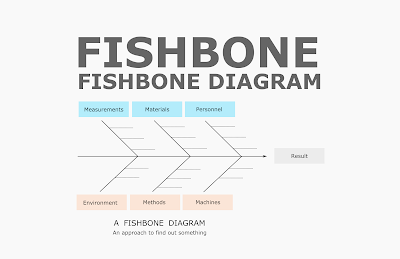What is Fishbone Diagram ?
Fishbone Diagram, an interesting name. It looks like a fish. Fishbone Diagram is one of the best techniques used in root cause analysis.
The diagram is named after Dr. Kaoru Ishikawa, University of Tokyo in 1943, who first developed and used fishbone diagram. That’s why, Fishbone diagram got another name as “Ishikawa”.
The diagram is named after Dr. Kaoru Ishikawa, University of Tokyo in 1943, who first developed and used fishbone diagram. That’s why, Fishbone diagram got another name as “Ishikawa”.
How is Fishbone Diagram Used ?
The great benefit of the fishbone diagram is its broad application. It can be applied to identify the causes of almost any problems like mechanical failures of a product, or designing to psychological issues.Advantages of Fishbone Diagram:
Advantages of Fishbone method are,- Straightly easy to learn and apply
- Good way to focus a brainstorming session
- Effective learning method to the whole team.
- Focuses discussion on the target issue
- Encourages “system thinking” via visual connections
- Puts further assessments and corrective actions
How to Develop Fishbone Diagram?
There are miscellaneous ways to develop a fishbone diagram and conduct it.One way is to put the categories of possible causes on the “bones” of the fish, each line representing one category, such as:
- Man (personnel)
- Machine
- Methods
- Materials
- Measurements
- Mother Nature (environment)
Who Should Take Fishbone Diagram Course ?
Audience,Tonex Training offers 2-days course and designed for all the individuals who want to learn and apply simple problem analysis tools. This hands-on seminar is ideal for the people like,
- Senior executives, strategic leaders
- Managers, quality managers
- Product managers, manufacturing managers
- R&D managers.
Learning Opportunities :
Learn about,- Concept of fishbone diagram
- Learn when to use a cause & effect diagram
- Creating effective fishbone diagram.
- Fishbone diagram benefits in root cause analysis
- Various approaches for fishbone diagram building.
Course Topics :
Fishbone Diagram Training topics can be adjusted as per your custom requirements,- Fundamentals of Fishbone diagram.
- Fishbone Diagram Procedure
- TONEX Fishbone Diagram Hands-On Workshop
Want To Learn More ?
Visit tonex.com for Fishbone Diagram Training, Ishikawa Training courses and workshop detail.
Fishbone Diagram Training


Comments
Post a Comment